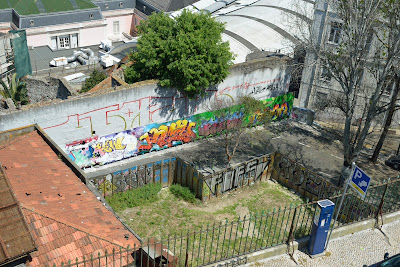Lisbon, Portugal
Lisbon is one of the busiest ports in Europe. Our maritime
approach up the Rio Tejo river took us under a suspension bridge (that very
much resembles the San Francisco Bay Bridge) to the “24th of April" port (that’s really its name, referring to Portugal’s independence). The cruise
ship dock area is filled with modern shops,
restaurants and bars.
restaurants and bars.
The bus that was scheduled to take us into the heart of the
city – about five kilometers away – stopped short by a kilometer because they
were afraid of potential radical demonstration activity near there. It was
after all, April 24. Sissies. As it turns out, the walking tour we had planned
out for ourselves took us directly through where the commotion was expected. We
decided to take a look.
It is highly unfortunate that the overall psyche of Lisbon
during the economic crises (I suspect before as well, but perhaps not as much)
has allowed there to be graffiti plastered over nearly every paintable surface
in sight. The city could use a serious
dose of high pressure washing too. But there were lots of narrow alleyways,
plazas and high vantage points throughout the city to discover so we noted the
degradation and continued on.
 Lisbon topography resembles San Francisco with its steep
hills as much as the suspension bridge does, however the city has a very
interesting approach to navigating the hills. There are public and private
outside elevators dotted throughout downtown that take you up or down a hundred
feet or so. When traveling with Eileen… you take the stairs.
Lisbon topography resembles San Francisco with its steep
hills as much as the suspension bridge does, however the city has a very
interesting approach to navigating the hills. There are public and private
outside elevators dotted throughout downtown that take you up or down a hundred
feet or so. When traveling with Eileen… you take the stairs.
The 150’ elevator pictured, the Elevador de Santa Justa, was designed by one of Gustav Eiffel’s (of
Paris’ Eiffel Tower fame) students. It’s certainly period-specific with its
Neo-Gothic motifs in the ornate iron work, but it continues in operation daily
since it was completed in 1902.
 Electric trolleys and funiculars are still used to get
around the center city because in many areas they’re the only transportation
that can navigate the narrow streets and hills. The originals built in the
1920’s were all made in America so many older residents continue to call them
Americanos.
Electric trolleys and funiculars are still used to get
around the center city because in many areas they’re the only transportation
that can navigate the narrow streets and hills. The originals built in the
1920’s were all made in America so many older residents continue to call them
Americanos.
Ah yes, the demonstration! As things turned out it amounted
to a peaceful march up a wide boulevard between major squares. The radicals stayed
home. The folk singers sounded a number of Joan Baez type anthems and that was
about it. Eileen and I decided we were parched and settled into a sidewalk café
for a couple of drafts. A 16 oz. pint was two Euros by the way, about $2.60,
including tip.














No comments:
Post a Comment